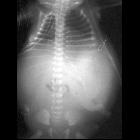Free fluid
















Ascites (hydroperitoneum is a rare synonym) is defined as an abnormal amount of intraperitoneal fluid.
Terminology
Ascites (plural is same word) tends to be reserved for relatively sizable amounts of peritoneal fluid. The amount has not been defined formally, however it is noted that physiologically there is 50-75 mL fluid in the abdominal cavity. So when only a small amount of fluid is present, which might be physiological, radiologists tend to use the term "free peritoneal fluid" or just free fluid instead. Occasionally the term trace ascites might be employed. It has been pointed out that the term free fluid would seem to not include small amounts of loculated fluid, as 'free' and 'loculated' are antonymic .
Clinical presentation
Patients with a large volume of ascites can present with abdominal distension (which may be painful), nausea, vomiting, dyspnea and peripheral edema .
Pathology
Ascitic fluid is traditionally characterized as either:
- transudate: thin, low protein count and low specific gravity
- exudate: high protein count and high specific gravity
More recently, the concept of the serum-ascites albumin gradient has been shown to be more accurate in the classification of the causes of ascites . For the purposes of simplicity, however, we maintain the former classification.
Etiology
Causes of transudative ascites:
- cirrhosis
- alcoholic hepatitis
- heart failure (CCF)
- hypoproteinemia
- portal vein thrombosis
- peritoneal dialysis (CAPD)
- malignancy (~10% of refractory ascites)
- most commonly: breast, ovarian, endometrial, gastrointestinal and pancreatic
Causes of exudative ascites:
- peritoneal carcinomatosis
- pancreatitis
- abscess
- nephrotic syndrome
- peritonitis, e.g. tuberculosis
- ischemic bowel
- bowel obstruction
Radiographic features
Plain radiograph
Detection of intraperitoneal fluid on a plain radiograph requires at least 500 mL to be present.
Plain radiograph findings of ascites include:
- diffusely increased density of the abdomen
- poor definition of the soft tissue shadows, such as the psoas muscles, liver and spleen
- medial displacement of bowel and solid viscera (away from the properitoneal fat stripe)
- bulging of the flanks
- increased separation of small bowel loops
- dog ear sign: represents fluid in pelvic peritoneal recess
Ultrasound
May detect smaller volumes especially if they are adjacent to the diaphragm or anterior margin of the liver . Assessment of fluid type:
- simple ascites is anechoic
- exudative, hemorrhagic or neoplastic ascites contains floating debris
- septations suggest an inflammatory or neoplastic cause and may be called a loculated ascites
CT
CT is most sensitive to small amounts of fluid in the peritoneum which collects preferentially in the dependent regions, such as Morison pouch and the pelvis. The CT density of intraperitoneal fluid may give a clue to the underlying etiology:
- transudative ascites density should be approximate to that of water (-10 to +10 HU)
- exudative ascites (density >15 HU)
- hemoperitoneum density is higher still (~45 HU)
Of course, other intra- or extra-abdominal CT features may give further evidence to the origin of the ascites (e.g. features of heart failure, features of cirrhosis, peritoneal catheter in situ, etc).
Treatment and prognosis
Medical management includes a modified diet (restricting sodium) and the use of medications such as diuretics . Interventional techniques for management include serial paracentesis (ascitic tap), TIPS or peritoneovenous shunting .
Ascitic taps are the most common and thought to be the most effective treatment for symptomatic ascites . It can be performed with a variety of techniques depending on the institution and the availability of imaging resources :
- blind: i.e. non-imaging guided
- partially imaging-guided: an appropriate site is marked on the abdominal wall using ultrasound but the puncture is blind
- imaging-guided: usually using ultrasound
Differential diagnosis
Consider other causes of intraperitoneal fluid:
- physiological: small amount of pelvic fluid may be normal in young females
- choleperitoneum: biloma/bile leak, e.g. from cholecystectomy
- chyloperitoneum (chylous ascites)
- hemoperitoneum
- uroperitoneum: urinoma/urine leak, e.g. from bladder trauma
- pancreatic ascites
Siehe auch:
- Leberzirrhose
- Pseudomyxoma peritonei
- portale Hypertension
- Tuberkulose des Peritoneums
- Mastozytose
- Budd-Chiari-Syndrom
- malignant ascites
- pseudoascites
- fetal urinary ascites
- Venenverschlusskrankheit der Leber
- fetaler Aszites
- Aszites in der Abdomenübersichtsaufnahme
- Aszitespunktion
und weiter:
- subkapsuläres Leberhämatom
- transjugulärer intrahepatischer portosystemischer Shunt
- Mekoniumperitonitis
- Gallenblasendrainage
- HELLP-Syndrom
- Child-Pugh-Score
- response evaluation criteria in solid tumours
- Spontan bakterielle Peritonitis
- Aszites bei Kindern
- spontane Aszitesentleerung über Nabelhernie
- Peritonealpunktion

 Assoziationen und Differentialdiagnosen zu Aszites:
Assoziationen und Differentialdiagnosen zu Aszites:






